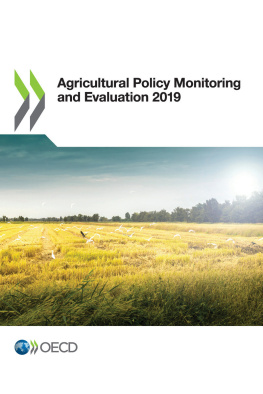OECD - OECD Employment Outlook 2016
Here you can read online OECD - OECD Employment Outlook 2016 full text of the book (entire story) in english for free. Download pdf and epub, get meaning, cover and reviews about this ebook. year: 2016, publisher: OECD Publishing, genre: Politics. Description of the work, (preface) as well as reviews are available. Best literature library LitArk.com created for fans of good reading and offers a wide selection of genres:
Romance novel
Science fiction
Adventure
Detective
Science
History
Home and family
Prose
Art
Politics
Computer
Non-fiction
Religion
Business
Children
Humor
Choose a favorite category and find really read worthwhile books. Enjoy immersion in the world of imagination, feel the emotions of the characters or learn something new for yourself, make an fascinating discovery.

OECD Employment Outlook 2016: summary, description and annotation
We offer to read an annotation, description, summary or preface (depends on what the author of the book "OECD Employment Outlook 2016" wrote himself). If you haven't found the necessary information about the book — write in the comments, we will try to find it.
OECD: author's other books
Who wrote OECD Employment Outlook 2016? Find out the surname, the name of the author of the book and a list of all author's works by series.
OECD Employment Outlook 2016 — read online for free the complete book (whole text) full work
Below is the text of the book, divided by pages. System saving the place of the last page read, allows you to conveniently read the book "OECD Employment Outlook 2016" online for free, without having to search again every time where you left off. Put a bookmark, and you can go to the page where you finished reading at any time.
Font size:
Interval:
Bookmark:

Flicitations et merci davoir tlcharg lun de nos tout nouveaux ePub en version bta.
Nous exprimentons ce nouveau format pour nos publications. En effet, mme si lePub est formidable pour des livres composs de texte linaire, le lecteur peut tre confront quelques dysfonctionnements avec les publications comportant des tableaux et des graphiques tout dpend du type de support de lecture que vous utilisez.
Afin de profiter dune exprience de lecture optimale, nous vous recommandons :
- Dutiliser la dernire version du systme dexploitation de votre support de lecture.
- De lire en orientation portrait.
- De rduire la taille de caractres si les tableaux en grand format sont difficiles lire.
Comme ce format est encore en version bta, nous aimerions recevoir vos impressions et remarques sur votre exprience de lecture, bonne ou autre, pour que nous puissions lamliorer lavenir. Dans votre message, merci de bien vouloir nous indiquer prcisment quel appareil et quel systme dexploitation vous avez utilis ainsi que le titre de la publication concerne. Vous pouvez adresser vos remarques ladresse suivante :
Merci !
Congratulations and thank-you for downloading one of our brand-new ePub-in-beta editions.
We're experimenting with this new format and, while ePub is fantastic for books with linear text, for books with charts, tables and graphs weve found some things may not work perfectly it depends on the device youre using.
So, for an optimal reading experience, we recommend:
- Using the latest version of your devices operating system.
- Reading in portrait mode.
- If large tables are tricky to read, try reducing the text size.
As this is an ePub-in-beta edition, we would be glad to receive feedback on your reading experience, good or otherwise, so we can improve for the future. When writing, please let us know which device/operating system you were using and the title of the publication. Write to:
Thank you!
OECD (2016), OECD Employment Outlook 2016, OECD Publishing, Paris, http://dx.doi.org/10.1787/empl_outlook-2016-en.

Details of revisions available at: www.oecd.org/about/publishing/Corrigendum-EMO2016.pdf
The OECD Employment Outlook provides an annual assessment of key labour market developments and prospects in OECD member countries. Each edition also contains several chapters focusing on specific aspects of how labour markets function and the implications for policy in order to promote more and better jobs. This years chapters cover vulnerable youth, job quality, skills use at work, the short-term effects of structural reforms, and labour market gender gaps in emerging economies. Reference statistics are also included.
The 2016 OECD Employment Outlook is the joint work of staff of the Directorate for Employment, Labour and Social Affairs. It has greatly benefited from contributions from national government delegates. However, the Outlook s assessments of each countrys labour market prospects do not necessarily correspond to those made by the national authorities concerned.
This report was edited by Paul Swaim, and is based on contributions from Andrea Garnero, Pascal Marianna and Paul Swaim (). Research assistance was provided by Dana Blumin, Sylvie Cimper, Paulina Granados-Zambrano, Sbastien Martin and Agns Puymoyen. Editorial assistance was provided by Gabriela Bejan, Natalie Corry, Monica Meza-Essid and Marlne Mohier.
Labour markets continue to recover from the Great Recession, albeit in a painfully slow manner in many OECD countries. While progress has been made in reversing the crisis-related increase in unemployment, little progress has been made in recouping the lost ground on wages. Overall, three-quarters of OECD countries still face either a sizeable unemployment gap an unemployment rate that is 2 percentage points or more above the pre-crisis level or a sizeable wage gap average wages at least 5% below the level they would be at if they had continued the trend increase during 2000-07 or both.
The slow progress in mending the labour market is largely the result of the global economy being in a low-growth trap characterised by low investment, anaemic productivity gains and weak job creation with stagnant wages. There is an urgent need to make full use of all policy tools macroeconomic and structural policies at the international and national level to bring back stronger and sustainable growth while ensuring that its benefits are shared more widely. Employment policies can and should play an important role in this endeavour. This edition of the OECD Employment Outlook helps to define the nature of this challenge and identifies a number of policy actions that could play an important role in helping to make the labour market more dynamic and inclusive, even in the face of persistent economic headwinds.
The end is in sight as regards cyclically depressed employment rates, at least for the OECD area as a whole. The jobs recovery has been underway since the first quarter of 2010 when the OECD average employment rate reached its post-crisis trough with only 58.6% of the population (ages 15-74 years) employed. This was 2.2 percentage points lower than the employment rate in 2007, corresponding to 20.3 million missing jobs. Despite the slow and uneven nature of the economic recovery, the jobs deficit had fallen to 5.6 million by the end of 2015 and this edition of the Outlook reports that the OECD now projects that the jobs gap will close completely during the course of 2017. While this is welcome news, the fact that the Great Recession depressed employment for nearly ten years testifies to its severity and the price workers have paid.
Font size:
Interval:
Bookmark:
Similar books «OECD Employment Outlook 2016»
Look at similar books to OECD Employment Outlook 2016. We have selected literature similar in name and meaning in the hope of providing readers with more options to find new, interesting, not yet read works.
Discussion, reviews of the book OECD Employment Outlook 2016 and just readers' own opinions. Leave your comments, write what you think about the work, its meaning or the main characters. Specify what exactly you liked and what you didn't like, and why you think so.










